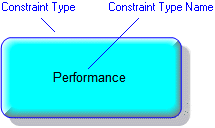Constraint type (dictionary item)

For automation interface information about a Constraint Type, click here
Constraint type (automation interface).
A Constraint Type allows you to organize Constraints and Constraint Types into sets of related items. Two associated Constraint Types will have a parent-child relationship, with an arrow pointing from parent to child on the Constraints Diagram.
You can create a Constraint Type through the context menu of a Package: right-click the Package, and select > > > . In addition, you can create a Constraint Type through a constraints Diagram.
When used on a Constraints Diagram, a Constraint Type's notation is as follows:

The following sections provide information about how a Constraint Type is used in the model. For more information about a property, item, model part or diagram, click it.
Properties
In addition to the
standard properties a Constraint Type has these properties:
The Options tab of a Constraint Type's Property Pages displays the name of a linked Constraint Type. |
Owned by
Owns
 Dependency —The Dependency is owned jointly by the Constraint Type and the other associated item. The access permissions you have to a Dependency are determined by the access permissions of the dependent item.
Dependency —The Dependency is owned jointly by the Constraint Type and the other associated item. The access permissions you have to a Dependency are determined by the access permissions of the dependent item.Defined in these parts of the model
Shown on these diagrams
Can be linked to these dictionary items
 Constraint —The linked Constraint is organized by the Constraint Type.
Constraint —The linked Constraint is organized by the Constraint Type. Constraint Type —The linked Constraint Type is organized by the Constraint Type, forming Constraint Type structures.
Constraint Type —The linked Constraint Type is organized by the Constraint Type, forming Constraint Type structures. on the Constraint Type's icon indicates that the item is a
on the Constraint Type's icon indicates that the item is a
 Model
Model Package
Package Comment
Comment Constraints Model
Constraints Model Constraints Diagram
Constraints Diagram Variant Diagram
Variant Diagram Stereotype
Stereotype